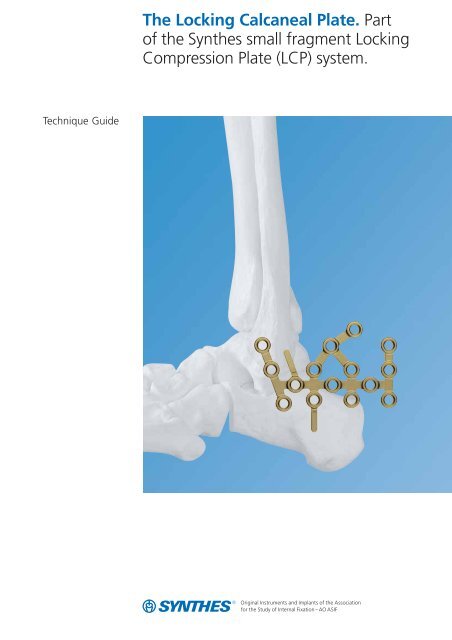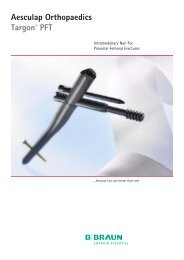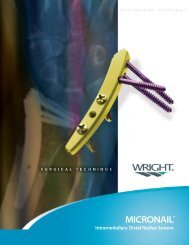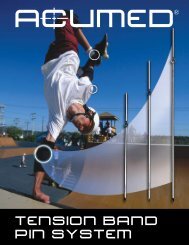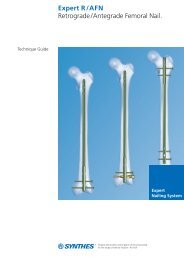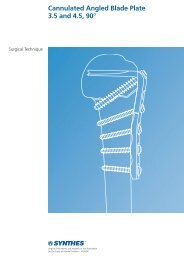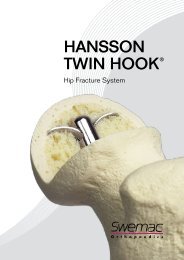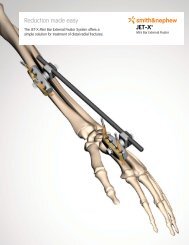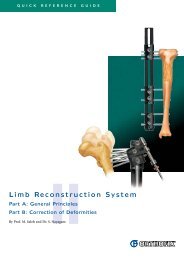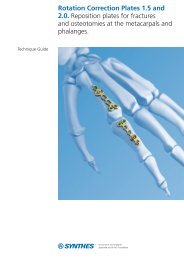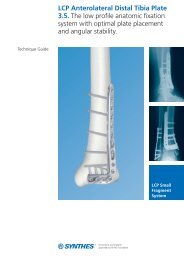The Locking Calcaneal Plate. Part of the Synthes small fragment ...
The Locking Calcaneal Plate. Part of the Synthes small fragment ...
The Locking Calcaneal Plate. Part of the Synthes small fragment ...
You also want an ePaper? Increase the reach of your titles
YUMPU automatically turns print PDFs into web optimized ePapers that Google loves.
Technique Guide<br />
<strong>The</strong> <strong>Locking</strong> <strong>Calcaneal</strong> <strong>Plate</strong>. <strong>Part</strong><br />
<strong>of</strong> <strong>the</strong> Syn<strong>the</strong>s <strong>small</strong> <strong>fragment</strong> <strong>Locking</strong><br />
Compression <strong>Plate</strong> (LCP) system.
Table <strong>of</strong> Contents<br />
Introduction<br />
Features and Benefits 2<br />
AO ASIF Principles 3<br />
Indications 4<br />
Surgical Technique<br />
Surgical Approach 5<br />
Reduction 6<br />
Cut/Contour <strong>Plate</strong> 7<br />
Secure <strong>Plate</strong> to Bone 9<br />
Closure 12<br />
Product Information<br />
Implants 13<br />
Instruments 14<br />
Sets 15<br />
Bibliography<br />
16<br />
Image intensifier control<br />
Warning<br />
This description is not sufficient for immediate application<br />
<strong>of</strong> <strong>the</strong> instrumentation. Instruction by a surgeon experienced<br />
in handling this instrumentation is highly recommended.<br />
Syn<strong>the</strong>s 1
Features and Benefits<br />
<strong>Plate</strong> features<br />
– Available in extra-<strong>small</strong>, <strong>small</strong>, large and extra-large in left<br />
and right designs<br />
– Versatile – 15 locking holes address multiple fracture<br />
patterns<br />
– Bendable tabs provide support for <strong>the</strong> anterior process and<br />
plantar <strong>fragment</strong>s<br />
– Angled and ascending holes (indicated by arrows) buttress<br />
<strong>the</strong> sustentaculum and provide better support <strong>of</strong> <strong>the</strong> calcaneotalar<br />
articular surface<br />
– Lateral application<br />
– <strong>Locking</strong> screws provide standard bicortical and/or<br />
unicortical fixation<br />
Threaded locking holes<br />
– Offer a fixed-angle construct to buttress <strong>the</strong> articular<br />
surfaces <strong>of</strong> <strong>the</strong> calcaneus<br />
– Permit multiple points <strong>of</strong> fixation to buttress <strong>small</strong><br />
<strong>fragment</strong>s<br />
– Accept standard 2.7 mm and 3.5 mm cortex screws as<br />
alternatives to, or in conjunction with, 3.5 mm locking<br />
screws<br />
– Provide 15° <strong>of</strong> angulation when using 2.7 mm cortex<br />
screws and 5° <strong>of</strong> angulation when using 3.5 mm cortex<br />
screws<br />
Stardrive recess<br />
Self-tapping flute<br />
<strong>Locking</strong><br />
threads<br />
Cortical thread<br />
pr<strong>of</strong>ile<br />
2 Syn<strong>the</strong>s <strong>The</strong> <strong>Locking</strong> <strong>Calcaneal</strong> <strong>Plate</strong> Technique Guide
AO ASIF Principles<br />
In 1958, <strong>the</strong> AO ASIF (Association for <strong>the</strong> Study <strong>of</strong><br />
Internal Fixation) formulated four basic principles, which<br />
have become <strong>the</strong> guidelines for internal fixation: 1<br />
Anatomic reduction<br />
Fracture reduction and fixation to restore anatomical<br />
relationships.<br />
Stable fixation<br />
Stability by fixation or splintage, as <strong>the</strong> personality <strong>of</strong><br />
<strong>the</strong> fracture and <strong>the</strong> injury requires. (<strong>The</strong> products optimize<br />
purchase for maximum compression and stability.)<br />
Preservation <strong>of</strong> blood supply<br />
Preservation <strong>of</strong> <strong>the</strong> blood supply to s<strong>of</strong>t tissue and bone by<br />
careful handling. (Use <strong>of</strong> surgical technique that minimizes<br />
disruption <strong>of</strong> s<strong>of</strong>t tissue and preserves vascular blood flow<br />
for bone healing.)<br />
Early mobilization<br />
Early and safe mobilization <strong>of</strong> <strong>the</strong> part and patient. (<strong>The</strong><br />
implants, combined with AO technique, provide stable<br />
fracture fixation with minimal trauma to vascular supply.)<br />
1<br />
M.E. Müller, M. Allgöwer, R. Schneider, and H. Willenegger (1991) AO Manual <strong>of</strong><br />
Internal Fixation, 3rd Edition. Berlin: Springer.<br />
Syn<strong>the</strong>s 3
Indications<br />
Indications<br />
<strong>The</strong> locking calcaneal plates address complex fractures <strong>of</strong> <strong>the</strong><br />
calcaneus.<br />
<strong>The</strong> locking calcaneal plate is indicated for fractures and<br />
osteotomies <strong>of</strong> <strong>the</strong> calcaneus including, but not limited to,<br />
extra-articular, intra-articular, joint depression, tongue type,<br />
and severely comminuted fractures.<br />
4 Syn<strong>the</strong>s <strong>The</strong> <strong>Locking</strong> <strong>Calcaneal</strong> <strong>Plate</strong> Technique Guide
Surgical Approach<br />
Place <strong>the</strong> patient in lateral decubitus position. Make an<br />
extensile, right-angled lateral incision. <strong>The</strong> vertical portion <strong>of</strong><br />
<strong>the</strong> incision should be just anterior to <strong>the</strong> heel cord and extend<br />
down to <strong>the</strong> plantar and lateral skin junction. Continue<br />
<strong>the</strong> incision forward, horizontally, exposing <strong>the</strong> calcaneocuboid<br />
joint. <strong>The</strong> incision is carried straight down to<br />
bone at its angle and <strong>the</strong>n developed to allow a single, thick<br />
flap to be lifted from <strong>the</strong> periosteal surface. This approach<br />
allows raising a single flap consisting <strong>of</strong> skin and s<strong>of</strong>t tissue<br />
which includes <strong>the</strong> peroneal tendons, sural nerve and <strong>the</strong><br />
detached calcane<strong>of</strong>ibular ligament.<br />
A “no-touch” technique may be employed by retracting<br />
<strong>the</strong> flap with Kischner wires in <strong>the</strong> talus and in <strong>the</strong> cuboid, or<br />
with an oral surgery tongue retractor.<br />
Note: Care must be taken to avoid prolonged traction <strong>of</strong> <strong>the</strong><br />
flap, especially if Kischner wires are used.<br />
Syn<strong>the</strong>s 5
Reduction<br />
1<br />
Reduce <strong>the</strong> fracture<br />
Reduce fracture <strong>fragment</strong>s. If Kirschner wires are used to<br />
temporarily reduce <strong>the</strong> fracture, <strong>the</strong>y must be placed to<br />
avoid interference with final plate placement. To accomplish<br />
this, lay a plate or bending template on <strong>the</strong> calcaneus.<br />
Note: A Schanz screw and universal chuck with T-Handle,<br />
or <strong>the</strong> Syn<strong>the</strong>s <strong>small</strong> distractor, can be used to aid in <strong>the</strong><br />
reduction <strong>of</strong> fracture <strong>fragment</strong>s.<br />
<strong>The</strong> proximal tab should be placed in front <strong>of</strong> <strong>the</strong> crucial<br />
angle <strong>of</strong> Gissane to push down <strong>the</strong> anterior process <strong>fragment</strong>.<br />
2<br />
Shape <strong>the</strong> template<br />
Instruments<br />
329.606 Bending Template for <strong>Calcaneal</strong> <strong>Locking</strong><br />
<strong>Plate</strong>s 3.5, extra-<strong>small</strong>, length 64 mm<br />
329.607 Bending Template for <strong>Calcaneal</strong> <strong>Locking</strong><br />
<strong>Plate</strong>s 3.5, <strong>small</strong>, length 69 mm<br />
329.608 Bending Template for <strong>Calcaneal</strong> <strong>Locking</strong><br />
<strong>Plate</strong>s 3.5, large, length 76 mm<br />
329.609 Bending Template for <strong>Calcaneal</strong> <strong>Locking</strong><br />
<strong>Plate</strong>s 3.5, extra-large, length 81 mm<br />
Temporarily position <strong>the</strong> appropriate bending template over<br />
<strong>the</strong> calcaneus. Verify template length and contour.<br />
Use <strong>the</strong> template to assist in selecting <strong>the</strong> appropriate plate<br />
length (extra-<strong>small</strong>, <strong>small</strong>, large or extra large).<br />
Note: <strong>The</strong> bending template can be used for ei<strong>the</strong>r left or<br />
right plate.<br />
6 Syn<strong>the</strong>s <strong>The</strong> <strong>Locking</strong> <strong>Calcaneal</strong> <strong>Plate</strong> Technique Guide
Cut / Contour <strong>Plate</strong><br />
3<br />
Cut/contour <strong>the</strong> plate<br />
Instruments<br />
329.916 Bending Pin for LCP <strong>Plate</strong>s 3.5, with thread<br />
391.963 Universal Bending Pliers, length 165 mm<br />
329.151 Cutting Pliers with Positioning Pin<br />
3.0 mm<br />
If necessary, remove a hole or tab <strong>of</strong> <strong>the</strong> plate using <strong>the</strong><br />
cutting pliers. A combination <strong>of</strong> holes and/or tabs may be<br />
removed as needed. Place <strong>the</strong> plate into jaws <strong>of</strong> <strong>the</strong> cutter<br />
as shown.<br />
Note: <strong>The</strong> hole or tab to be removed should be inside <strong>the</strong><br />
jaws as depicted. To aid in alignment, <strong>the</strong> adjacent plate hole<br />
should be positioned on <strong>the</strong> seating pin.<br />
Due to calcaneal s<strong>of</strong>t tissue anatomy, it may be helpful to<br />
pre-bend <strong>the</strong> superior and inferior tabs prior to plate application.<br />
Using <strong>the</strong> universal bending pliers, contour <strong>the</strong> tabs in<br />
fine increments until a desired fit is achieved.<br />
Syn<strong>the</strong>s 7
Cut / Contour <strong>Plate</strong><br />
Using <strong>the</strong> appropriate bending template as a guide, contour<br />
<strong>the</strong> plate using <strong>the</strong> universal bending pliers until an acceptable<br />
fit is achieved.<br />
Note: With a well-reduced calcaneus, it should not be<br />
necessary to contour <strong>the</strong> longitudinal axis <strong>of</strong> <strong>the</strong> plate.<br />
If necessary, fine bending may be achieved in situ with two<br />
bending pins for LCP plates. Thread one holder into a hole<br />
and thread a second holder into an adjacent hole. Apply<br />
<strong>small</strong> incremental force to achieve <strong>the</strong> required bending.<br />
Warning: Care should be taken to avoid overbending<br />
because <strong>the</strong> holders may become dislodged from <strong>the</strong> plate<br />
hole and damage <strong>the</strong> plate threads.<br />
8 Syn<strong>the</strong>s <strong>The</strong> <strong>Locking</strong> <strong>Calcaneal</strong> <strong>Plate</strong> Technique Guide
Secure <strong>Plate</strong> to Bone<br />
4<br />
Secure plate to bone<br />
Instruments<br />
310.210 Drill Bit 2.0 mm, length 125/100 mm,<br />
2-flute, for Quick Coupling<br />
or<br />
310.190 Drill Bit 2.0 mm, length 100/75 mm,<br />
2-flute, for Quick Coupling<br />
310.230 Drill Bit 2.5 mm, length 180/155 mm,<br />
2-flute, for Quick Coupling<br />
or<br />
310.250 Drill Bit 2.5 mm, length 110/85 mm,<br />
2-flute, for Quick Coupling<br />
310.280 Drill Bit 2.7 mm, length 125/100 mm,<br />
2-flute, for Quick Coupling<br />
310.284 LCP Drill Bit 2.8 mm with Stop, length<br />
165 mm, 2-flute, for Quick Coupling<br />
310.350 Drill Bit 3.5 mm, length 110/85 mm,<br />
2-flute, for Quick Coupling<br />
323.027 LCP Drill Sleeve 3.5, for Drill Bits 2.8 mm<br />
314.020 Screwdriver, hexagonal, <strong>small</strong>, with<br />
Holding Sleeve<br />
314.116 Screwdriver Shaft Stardrive 3.5, T15,<br />
self-holding, for AO/ASIF Quick Coupling<br />
319.010 Depth Gauge for Screws 2.7 to 4.0 mm,<br />
measuring range up to 60 mm<br />
323.260 Universal Drill Guide 2.7<br />
323.360 Universal Drill Guide 3.5<br />
511.770 Torque Limiter, 1.5 Nm, for Compact Air<br />
Drive and for Power Drive<br />
Determine whe<strong>the</strong>r 2.7 mm or 3.5 mm Cortex Screws or<br />
3.5 mm <strong>Locking</strong> Screws will be used for fixation. A combination<br />
<strong>of</strong> all three screws may be used.<br />
Note: If a combination <strong>of</strong> cortex and locking screws is used,<br />
a cortex screw should be used first to achieve plate-to-bone<br />
contact.<br />
A. To secure <strong>the</strong> plate with 2.7 mm cortex screws, insert <strong>the</strong><br />
2.0 mm end <strong>of</strong> <strong>the</strong> 2.7 mm universal drill guide into <strong>the</strong><br />
plate hole and drill through both cortices with a 2.0 mm<br />
drill bit.<br />
Measure for screw length using <strong>the</strong> depth gauge.<br />
Select and insert an appropriate length 2.7 mm self-tapping<br />
cortex screw using <strong>the</strong> <strong>small</strong> hexagonal screwdriver.<br />
Note: To lag a 2.7 mm screw through a plate hole, use a<br />
2.7 mm drill bit to overdrill <strong>the</strong> near cortex. Insert <strong>the</strong><br />
2.7 mm end <strong>of</strong> <strong>the</strong> 2.7 mm universal drill guide into <strong>the</strong><br />
plate hole and drill through <strong>the</strong> near cortex with a 2.7 mm<br />
drill bit.<br />
Syn<strong>the</strong>s 9
Secure <strong>Plate</strong> to Bone<br />
B. To secure <strong>the</strong> plate with 3.5 mm cortex screws, insert <strong>the</strong><br />
2.5 mm end <strong>of</strong> <strong>the</strong> 3.5 mm universal drill guide into a<br />
plate hole and drill through both cortices with a 2.5 mm<br />
drill bit.<br />
Measure for screw length using <strong>the</strong> depth gauge.<br />
Select and insert an appropriate length 3.5 mm self-tapping<br />
cortex screw using <strong>the</strong> stardrive screwdriver or <strong>the</strong> <strong>small</strong><br />
hexagonal screwdriver, whichever is appropriate.<br />
Note: To lag a 3.5 mm cortex screw through a plate hole,<br />
use a 3.5 mm drill bit to overdrill <strong>the</strong> near cortex. Insert <strong>the</strong><br />
3.5 mm end <strong>of</strong> <strong>the</strong> 3.5 mm universal drill guide into <strong>the</strong><br />
plate hole and drill through <strong>the</strong> near cortex with a 3.5 mm<br />
drill bit.<br />
C. To secure <strong>the</strong> plate with 3.5 mm locking screws, screw<br />
<strong>the</strong> 2.8 mm threaded drill guide into a threaded plate<br />
hole until seated.<br />
Note: To assure <strong>the</strong> locking screw seats itself fully into <strong>the</strong><br />
threaded hole, <strong>the</strong> threaded drill guide must be used to ensure<br />
<strong>the</strong> proper drilling angle.<br />
Warning: Do not bend <strong>the</strong> plate using <strong>the</strong> threaded drill<br />
guide because damage may occur to <strong>the</strong> plate threads<br />
and/or guide.<br />
10 Syn<strong>the</strong>s <strong>The</strong> <strong>Locking</strong> <strong>Calcaneal</strong> <strong>Plate</strong> Technique Guide
Using <strong>the</strong> 2.8 mm drill bit through <strong>the</strong> threaded drill guide,<br />
drill through both cortices.<br />
Remove <strong>the</strong> drill guide.<br />
Measure for screw length using <strong>the</strong> depth gauge.<br />
Note: 3.5 mm locking screws, with stardrive recess, are<br />
included in <strong>the</strong> locking calcaneal plate and screw instrument<br />
and implant set however, 3.5 mm locking screws with <strong>small</strong><br />
hexagonal recess may also be used.<br />
Insert <strong>the</strong> appropriate length 3.5 mm self-tapping locking<br />
screw under power using a torque limiting attachment (TLA)<br />
and Stardrive screwdriver shaft, or <strong>small</strong> hexagonal screwdriver<br />
shaft, as appropriate.<br />
Note: <strong>The</strong> screw is securely locked to <strong>the</strong> plate when a<br />
“click” is heard.<br />
Warning: Never use a screwdriver shaft with power equipment<br />
unless used with a torque limiting attachment.<br />
Alternative method <strong>of</strong> locking screw insertion<br />
Manually insert <strong>the</strong> appropriate length 3.5 mm self-tapping<br />
locking screw using <strong>the</strong> stardrive screwdriver or <strong>small</strong> hexagonal<br />
screwdriver, as appropriate. Carefully tighten <strong>the</strong> locking<br />
screw, as excessive force is not necessary to produce effective<br />
screw-to-plate locking.<br />
Syn<strong>the</strong>s 11
Closure<br />
5<br />
Closure<br />
Close <strong>the</strong> wound in a routine fashion.<br />
12 Syn<strong>the</strong>s <strong>The</strong> <strong>Locking</strong> <strong>Calcaneal</strong> <strong>Plate</strong> Technique Guide
Implants<br />
X41.618 <strong>Calcaneal</strong> <strong>Locking</strong> <strong>Plate</strong> 3.5, right,<br />
extra-<strong>small</strong>, length 64 mm<br />
X41.619 <strong>Calcaneal</strong> <strong>Locking</strong> <strong>Plate</strong> 3.5, left,<br />
extra-<strong>small</strong>, length 64 mm<br />
X41.622 <strong>Calcaneal</strong> <strong>Locking</strong> <strong>Plate</strong> 3.5, right,<br />
<strong>small</strong>, length 69 mm<br />
X41.623 <strong>Calcaneal</strong> <strong>Locking</strong> <strong>Plate</strong> 3.5, left,<br />
<strong>small</strong>, length 69 mm<br />
X41.624 <strong>Calcaneal</strong> <strong>Locking</strong> <strong>Plate</strong> 3.5, right,<br />
large, length 76 mm<br />
X41.625 <strong>Calcaneal</strong> <strong>Locking</strong> <strong>Plate</strong> 3.5, left,<br />
large, length 76 mm<br />
X41.626 <strong>Calcaneal</strong> <strong>Locking</strong> <strong>Plate</strong> 3.5, right,<br />
extra-large, length 81 mm<br />
X41.627 <strong>Calcaneal</strong> <strong>Locking</strong> <strong>Plate</strong> 3.5, left,<br />
extra-large, length 81 mm<br />
X = 2 Stainless Steel<br />
X = 4 Titanium<br />
<strong>Locking</strong> Screws<br />
X12.101 – 124 LCP <strong>Locking</strong> Screw Stardrive 3.5 mm,<br />
self-tapping, length 10 – 60 mm<br />
Standard Screws<br />
X02.820 – 860 Cortex Screw 2.7 mm, self-tapping,<br />
length 20 – 60 mm<br />
X04.810 – 860 Cortex Screw 3.5 mm, self-tapping,<br />
length 10 – 60 mm<br />
X = 2 Stainless Steel<br />
X = 4 Titanium<br />
Syn<strong>the</strong>s 13
Instruments<br />
323.027 LCP Drill Sleeve 3.5, for Drill Bits 2.8 mm<br />
314.116 Screwdriver Shaft Stardrive 3.5, T15,<br />
self-holding, for AO/ASIF Quick Coupling<br />
329.916 Bending Pin for LCP <strong>Plate</strong>s 3.5, with thread<br />
329.151 Cutting Pliers with Positioning Pin<br />
3.0 mm<br />
391.963 Universal Bending Pliers, length 165 mm<br />
329.606 Bending Template for <strong>Calcaneal</strong> <strong>Locking</strong><br />
<strong>Plate</strong>s 3.5, extra-<strong>small</strong>, length 64 mm<br />
329.607 Bending Template for <strong>Calcaneal</strong> <strong>Locking</strong><br />
<strong>Plate</strong>s 3.5, <strong>small</strong>, length 69 mm<br />
329.608 Bending Template for <strong>Calcaneal</strong> <strong>Locking</strong><br />
<strong>Plate</strong>s 3.5, large, length 76 mm<br />
329.609 Bending Template for <strong>Calcaneal</strong> <strong>Locking</strong><br />
<strong>Plate</strong>s 3.5, extra-large, length 81 mm<br />
14 Syn<strong>the</strong>s <strong>The</strong> <strong>Locking</strong> <strong>Calcaneal</strong> <strong>Plate</strong> Technique Guide
Sets<br />
– <strong>Calcaneal</strong> <strong>Locking</strong> <strong>Plate</strong> (Titanium) and LCP <strong>Locking</strong> Screws<br />
Stardrive (TAN) in Vario Case (182.709)<br />
– <strong>Calcaneal</strong> <strong>Locking</strong> <strong>Plate</strong> and LCP <strong>Locking</strong> Screws Stardrive<br />
(Stainless Steel) in Vario Case (182.710)<br />
Note: <strong>The</strong> locking calcaneal plates are also available in combination<br />
with <strong>the</strong> LCP Pilon <strong>Plate</strong> (182.705, TI; 182.706, SSt)<br />
and in combination with <strong>the</strong> LCP Pilon <strong>Plate</strong> and <strong>the</strong> LCP<br />
Distal Tibia <strong>Plate</strong> (182.711, Ti; 182.712, SSt)<br />
Syn<strong>the</strong>s 15
Bibliography<br />
Sanders, Roy (2002) Displaced Intra-Articular Fractures <strong>of</strong><br />
<strong>the</strong> Calcaneus. <strong>The</strong> Journal <strong>of</strong> Bone and Joint Surgery 2002;<br />
82-A: 225-250<br />
Sanders, Roy (1992) Intra-Articular Fractures <strong>of</strong> <strong>the</strong><br />
Calcaneus: Present State <strong>of</strong> <strong>the</strong> Art. Journal <strong>of</strong> Orthopaedic<br />
Trauma 1992; Vol. 6, No. 2, pp. 252-265<br />
Rodriguez-Merchan, E.C. and Galindo, E. (1999) Intra-articular<br />
displaced fractures <strong>of</strong> <strong>the</strong> calcaneus. Internal Orthopaedics<br />
(Sicot) 1999; 23: 63-65<br />
Sanders, Roy (1993) Operative Treatment in 120 Displaced<br />
Intraarticular <strong>Calcaneal</strong> Fractures. Clinical Orthopaedics and<br />
related research 1993; 290; pp. 87-95<br />
Thordarson, David B. and Krieger, Lauren Eric: Operative vs.<br />
Nonoperative Treatment <strong>of</strong> Intra-Articular Fractures <strong>of</strong> <strong>the</strong><br />
Calcaneus: A Prospective Randomized Trial. Foot and Ankle<br />
International; Vol. 17, No. 1, pp. 2-9<br />
Kerr, P.S. , Pape, M., Jackson, M., and Atkins, R.M. (1996)<br />
Early Experiences with <strong>the</strong> AO calcaneal fracture plate.<br />
Injury 1996; Vol. 27, No. 1, pp. 39-41<br />
Melcher, Gian, Degonda, Frena, Leutenegger, Adrian and<br />
Rüedi, Thomas: Ten-Year Follow-up after Operative Treatment<br />
for Intraarticular Fractures <strong>of</strong> <strong>the</strong> Calcaneus. <strong>The</strong><br />
Journal <strong>of</strong> Trauma, Injury, Infection and Critical care; Vol. 38,<br />
No. 5, pp. 713-716<br />
16 Syn<strong>the</strong>s <strong>The</strong> <strong>Locking</strong> <strong>Calcaneal</strong> <strong>Plate</strong> Technique Guide
Presented by:<br />
0123<br />
036.000.301 SE_103581 AA 31060020 © Syn<strong>the</strong>s 2007 LCP, Stardrive and Vario Case are trademarks <strong>of</strong> Syn<strong>the</strong>s Subject to modifications


